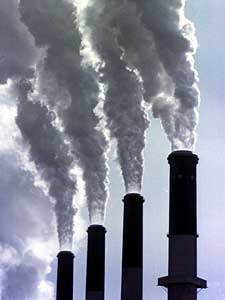• Metal smelting of sulfide-containing ores.
• Wood pulping and paper manufacturing,
Coal contains 0.5% of sulfur on average, in the form of metallic sulfides. In the combustion process sulfur is converted to sulfur dioxide:
S (in compound) + O2 (g) → SO2 (g)
Combustion of fossil fuels in power plants
4FeS2 (s) + 11O2 (g) → 2Fe2O3 (s) + 8SO2 (g)
Smelting sulphide ores
2ZnS + 3O2 → 2ZnO + 2SO2
Reasons for Concern
Health effects
Exposure to concentrations of 10 to 50 parts per million for 5 to 15 minutes causes irritation of the eyes, nose and throat, choking and coughing.
Exposure of the eyes to liquid sulfur dioxide, (from, for example an industrial accident) can cause severe burns, resulting in the loss of vision. On the skin it produces burns. Other health effects include headache, general discomfort and anxiety Children, the elderly, and people with asthma, cardiovascular disease or chronic lung disease (such as bronchitis or emphysema) are at increased risk. Repeated or prolonged exposure to moderate concentrations may cause inflammation of the respiratory tract, wheezing and lung damage. It has also proved to be harmful to the reproductive systems of experimental animals and caused developmental changes in their newborn.
Environmental effects
Sulfur dioxide is a potent and poisonous chemical that visibly damage the structure and appearance numerous plant species including valuable pines, legumes, red and black oaks, white ash, alfalfa and blackberry. This extent of the damage becomes apparent after a low exposure of 0.12 ppm for 8 hours. Visible injury can be obtained on plants of intermediate sensitivity after being exposed to .30ppm for 8 hours. In some instances, high levels of exposure to sulfur dioxide are beneficial for a limited range of plant species especially those growing in sulfur deficient soils. Low concentrations of sulfur dioxide can harm plants and trees and reduce crop productivity. Higher levels, and especially the acidic deposits from acid rain, will adversely affect both land and water ecosystems.
When dissolved in rain, it forms acid rain
SO2 (g) + H2O (l) → H2SO3 (aq)
 Oxides of nitrogen contribute to the formation of photochemical smog which is a serious problem in big cities especially in USA and Europe. If these oxides are inhaled by humans, could cause severe illnesses such as asthma and bronchitis.
Oxides of nitrogen contribute to the formation of photochemical smog which is a serious problem in big cities especially in USA and Europe. If these oxides are inhaled by humans, could cause severe illnesses such as asthma and bronchitis.Other effects
Other effects of sulfur dioxide include accelerated corrosion of metals through the formation of sulfuric acid, damage stone and masonry, paint, various fibres, paper, leather, and electrical components.


